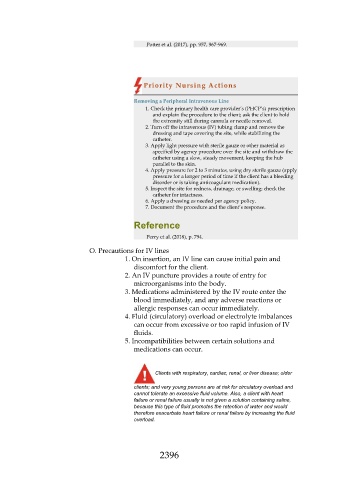Page 2396 - Saunders Comprehensive Review For NCLEX-RN
P. 2396
Potter et al. (2017), pp. 957, 967-969.
Priority Nursing Actions
Removing a Peripheral Intravenous Line
1. Check the primary health care provider’s (PHCP’s) prescription
and explain the procedure to the client; ask the client to hold
the extremity still during cannula or needle removal.
2. Turn off the intravenous (IV) tubing clamp and remove the
dressing and tape covering the site, while stabilizing the
catheter.
3. Apply light pressure with sterile gauze or other material as
specified by agency procedure over the site and withdraw the
catheter using a slow, steady movement, keeping the hub
parallel to the skin.
4. Apply pressure for 2 to 3 minutes, using dry sterile gauze (apply
pressure for a longer period of time if the client has a bleeding
disorder or is taking anticoagulant medication).
5. Inspect the site for redness, drainage, or swelling; check the
catheter for intactness.
6. Apply a dressing as needed per agency policy.
7. Document the procedure and the client’s response.
Reference
Perry et al. (2018), p. 794.
O. Precautions for IV lines
1. On insertion, an IV line can cause initial pain and
discomfort for the client.
2. An IV puncture provides a route of entry for
microorganisms into the body.
3. Medications administered by the IV route enter the
blood immediately, and any adverse reactions or
allergic responses can occur immediately.
4. Fluid (circulatory) overload or electrolyte imbalances
can occur from excessive or too rapid infusion of IV
fluids.
5. Incompatibilities between certain solutions and
medications can occur.
Clients with respiratory, cardiac, renal, or liver disease; older
clients; and very young persons are at risk for circulatory overload and
cannot tolerate an excessive fluid volume. Also, a client with heart
failure or renal failure usually is not given a solution containing saline,
because this type of fluid promotes the retention of water and would
therefore exacerbate heart failure or renal failure by increasing the fluid
overload.
2396

